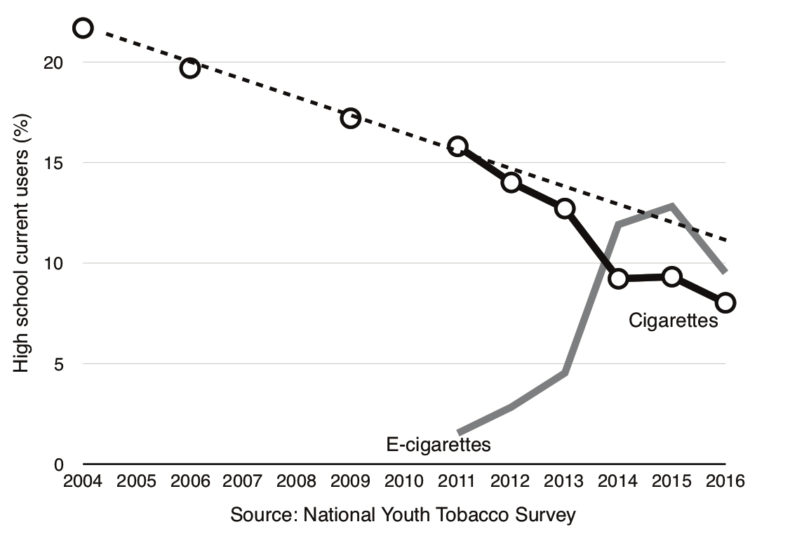Reading the latest story about vaping in today’s newspapers, you could be forgiven for thinking that it was still 2011. When e-cigarettes first became mainstream products, concerns were expressed about them being a “gateway” to tobacco and “re-normalising” smoking. As the years passed it became clear that these fears were unfounded. Every country that has embraced e-cigarettes has seen smoking rates decline among both adults and children.
The decline has been particularly dramatic in Britain where anti-smoking campaigners and health groups have been on board with vaping for several years. Despite draconian anti-smoking legislation, the smoking rate barely moved between 2007 and 2012, but once e-cigarettes took off, it fell by more than 20 per cent. The UK now has the second lowest smoking rate in the EU (after Sweden, where snus has taken over).
It was therefore surprising to read today that vaping is a “one-way bridge” to smoking. According to a group of doctors writing an editorial in the European Respiratory Journal, “electronic cigarette use is strongly associated with the subsequent initiation of combustible tobacco product use among adolescents”. They want e-cigarettes to be regulated like tobacco products, with a total ban on advertising, a ban on flavourings and a ban on vaping in all “indoor locations, public parks, and places where children and youths are present”.
Single issue campaigners are well aware that you can get almost anything banned by playing the think-of-the-children card. Nine times out of ten, it is a cynical device to restrict the choice of adults. In this instance, the policies proposed would not only restrict freedom but also damage health, since they would act as an effective deterrent to smokers who would otherwise switch to vaping.
Arguments for “gateway effects” are always dubious. They are typically espoused by people who don’t like an activity but cannot find a justification to ban it on its own terms. Cannabis is the classic example. Since marijuana has never killed anyone, supporters of the war on drugs resort to claims about it being a gateway to heroin. E-cigarettes have never killed anyone either and so anti-nicotine extremists resort to claims about vaping leading to smoking.
In both cases, correlations can be found, but it is fairly obvious that they are not causal. Teenagers who vape are more likely to smoke, but they are also more likely to ride motorcycles, watch X-rated movies and have unsafe sex. They are also more likely to smoke cannabis, for that matter, but that doesn’t mean that vaping leads to any of these behaviours, nor would they be less likely to engage in them if vaping didn’t exist.
If vaping is truly a gateway to smoking, where is the epidemic of teen smoking that should have followed in its wake? The authors of the editorial say that “electronic cigarette use among students has increased dramatically” in the US. And so it has, but it has coincided with a dramatic fall in cigarette smoking, as the graph below shows.

The dotted line shows the secular trend in smoking prevalence among high school students. It was falling steadily before vaping became popular but fell sharply thereafter. Coincidence? Possibly, but it certainly doesn’t suggest that large numbers of nonsmoking vapers are taking up smoking. It is not unlikely that high school students who would have started smoking if e-cigarettes did not exist have taken up vaping instead.
Not unlikely, but impossible to prove. The alternative theory — that e-cigarettes are a “one-way bridge to smoking” — is also impossible to prove, but that does not stop anti-vaping propagandists from stating it as fact.
And therein lies the problem. There is much to be learnt about the vaping phenomenon but while those who study the science are cautious in their conclusions, prohibitionist hucksters yell soundbites from the roof. This, combined with the media’s love of a good scare story, has allowed junk science to flourish and cranks to prosper. Even people who know nothing about vaping think they know that it causes “popcorn lung” (it almost certainly doesn’t).
It is an astonishing fact that more people in Britain and the US think that e-cigarettes are as dangerous, or more dangerous, than cigarettes than they did five years ago. The public health movement has failed in its most basic duty of educating the public about risk. In the UK, credit must be given to organisations such as Public Health England and Cancer Research UK for attempting to give people accurate information, but they are fighting an uphill battle against a co-ordinated campaign of quack science, doubt and diversion that is oddly reminiscent of the tobacco industry in the 1960s.
As I argued in my book Killjoys, consumers cannot make meaningfully free choices if they lack crucial information. The avalanche of misinformation about e-cigarettes has created something like a market failure. Why would a smoker switch to vaping if e-cigarettes are even worse for you? There are almost certainly smokers out there who would have made the switch if they were adequately informed about the relative risks. Addressing this information asymmetry should be a priority for the government. As the old public health message said: don’t die of ignorance.


